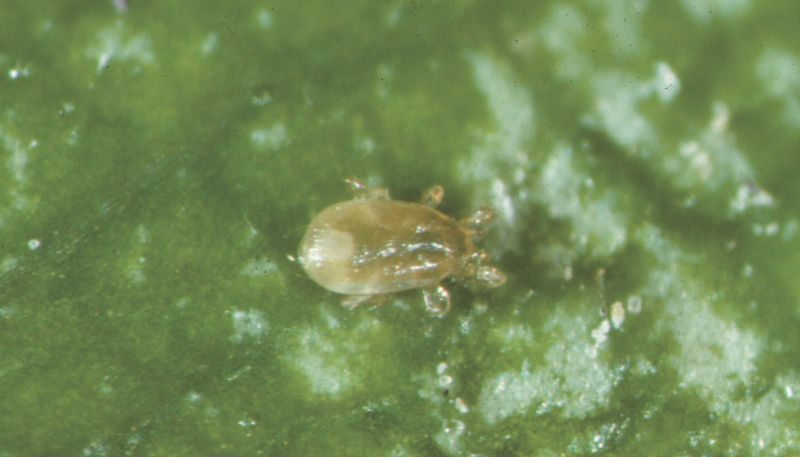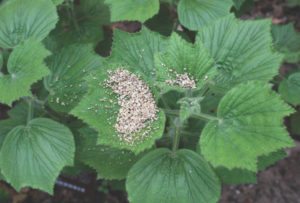
Predatory Mites That Eat Western Flower Thrips
Answer: Both are above-ground predatory mites widely used to regulate Western flower thrips populations in various greenhouse horticultural cropping systems including ornamentals and vegetables. Neoseiulus cucumeris and Amblyseius swirksii are considered type III predatory mites because they are generalist feeders; feeding not only on Western flower thrips but also on whiteflies, mites and even plant pollen. Both predatory mites feed on the first and/or second instar larvae of the Western flower thrips because adult western flower thrips defend themselves from predation by striking the predatory mites with their abdomen or exuding a wet substance that covers the predatory mites. Consequently, the predatory mites spend time cleaning (“grooming”) themselves instead of searching for Western flower thrips larvae.
Neoseiulus cucumeris is 0.5 to 1.0 mm long, which makes it difficult to see the predatory mite with the naked eye. The life cycle, from egg to adult, can be completed in nine to 12 days at 77° F with adults living up to 35 days. The optimum environmental conditions for activity are temperatures between 54 to 86° F and 70 to 80 percent relative humidity. Adult females lay an average of 35 eggs during their lifespan. The eggs are typically laid on leaf undersides, on leaf hairs (trichomes) located along the leaf midrib. There are five life stages: egg, larva, two nymphal stages and adult.
Neoseiulus cucumeris are typically located on leaf undersides or inside flowers feeding on Western flower thrips first instar larva. In addition to Western flower thrips, N. cucumeris has been reported to feed on broad mite (Polyphagotarsonemus latus), cyclamen mite (Phytonemus pallidus) and tomato russet mite (Aculops lycopersici). Neoseiulus cucumeris is commercially available from most biological control suppliers and is formulated (with a bran carrier) into several delivery systems including: buckets (100,000 predatory mites), bottles (50,000 predatory mites) or sachets (1,000 predatory mites). The bucket and bottle formulations contain bran mites (Tyrophagus putrescentiae) as a temporary food source. These formulations of the predatory mite are applied by means of sprinkling (by hand) the carrier along with the predatory mites onto plants. Sachets can be hung on plants. In addition, there is a formulation (“popsicle”) in which the sachet is attached to a stick that is inserted into the growing medium. Be sure that the sachets and “popsicle” formulations are protected from direct sunlight to avoid heat stress on the predatory mites.

Amblyseius swirskii is 0.5 mm long. Just like N. cucumeris, there are five life stages (egg, larva, two nymphal stages and adult). Development and adult lifespan are similar to N. cucumeris. At 77° F, the entire life cycle (egg to adult) may be completed in less than seven days. Adult females lay eggs on leaf hairs located on leaf undersides. The color of the predatory mite will vary from deep red to pale yellow depending on the prey type consumed.
In addition to being able to feed on plant pollen, A. swirskii will also feed on plant nectars; thus allowing the predatory mite to persist under low prey numbers or in the absence of prey. However, the development time from egg to adult is shorter when feeding on prey compared to pollen. Amblyseius swirskii prefers warm temperatures (optimum of 88° F) and high relative humidity (greater than 75 percent). Similar to N. cucumeris, A. swirksii feeds on a broad-range of pests including: thrips, whiteflies and mites. Amblyseius swirskii feeds on both the first and second instar larvae of the Western flower thrips. The predatory mite is formulated as either breeder packets or bottles for distribution within greenhouse crops.
Both predatory mites must be released preventatively or prior to the establishment of Western flower thrips populations, and before damage is noticed. Be sure to check that the predatory mites received are alive by placing a small sample of the bran carrier onto an 8.5×11-inch white sheet of paper, and use a 16X hand- lens to check for predatory mites moving around. If you have any questions or comments regarding the quality, release rates and appropriate environmental conditions required for both predatory mites, contact your biological control supplier immediately.


 Video Library
Video Library 




















